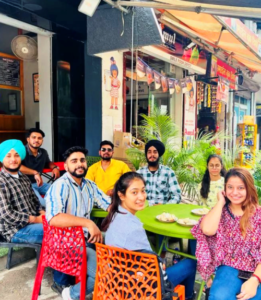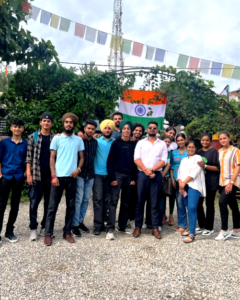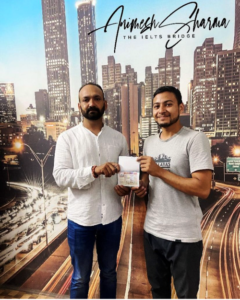Tea Times
A The chances are that you have already drunk a cup or glass of tea today. Perhaps, you are sipping one as you read this. Tea, now an everyday beverage in many parts of the world, has over the centuries been an important part of the rituals of hospitality both in the home and in wider society.
B Tea originated in China, and in Eastern Asia tea making and drinking ceremonies have been popular for centuries. Tea was first shipped to North Western Europe by English and Dutch maritime traders in the sixteenth century. At about the same time, a land route from the Far East, via Moscow, to Europe was opened up. Tea also figured in America’s bid for independence from British rule – the Boston Tea Party.
C As, over the last four hundred years, tea-leaves became available throughout much of Asia and Europe, the ways in which tea was drunk changed. The Chinese considered the quality of the leaves and the ways in which they were cured all important. People in other cultures added new ingredients besides tea-leaves and hot water. They drank tea with milk, sugar, spices like cinnamon and cardamom, and herbs such as mint or sage. The variations are endless. For example, in Western Sudan on the edge of the Sahara Desert, sesame oil is added to milky tea on cold mornings. In England tea, unlike coffee, acquired a reputation as a therapeutic drink that promoted health. Indeed, in European and Arab countries as well as in Persia and Russia, tea was praised for its restorative and health giving properties. One Dutch physician, Cornelius Blankaart, advised that to maintain health a minimum of eight to ten cups a day should be drunk, and that up to 50 to 100 daily cups could be consumed with safety.
D While European coffee houses were frequented by men discussing politics and closing business deals, respectable middle-class women stayed at home and held tea parties. When the price of tea fell in the nineteenth century poor people took up the drink with enthusiasm. Different grades and blends of tea were sold to suit every pocket.
E Throughout the world today, few religious groups object to tea drinking. In Islamic cultures, where drinking of alcohol is forbidden, tea and coffee consumption is an important part of social life. However, Seventh-Day Adventists, recognising the beverage as a drug containing the stimulant caffeine, frown upon the drinking of tea.
F Nomadic Bedouin are well known for traditions of hospitality in the desert. According to Middle Eastern tradition, guests are served both tea and coffee from pots kept ready on the fires of guest tents where men of the family and male visitors gather. Cups of ‘bitter’ cardamom coffee and glasses of sugared tea should be constantly refilled by the host.
G For over a thousand years, Arab traders have been bringing Islamic culture, including tea drinking, to northern and western Africa. Techniques of tea preparation and the ceremony involved have been adapted. In West African countries, such as Senegal and The Gambia, it is fashionable for young men to gather in small groups to brew Chinese ‘gunpowder’ tea. The tea is boiled with large amounts of sugar for a long time.
H Tea drinking in India remains an important part of daily life. There, tea made entirely with milk is popular. ‘Chai’ is made by boiling milk and adding tea, sugar and some spices. This form of tea making has crossed the Indian Ocean and is also popular in East Africa, where tea is considered best when it is either very milky or made with water only. Curiously, this ‘milk or water’ formula has been carried over to the preparation of instant coffee, which is served in cafes as either black, or sprinkled on a cup of hot milk
I In Britain, coffee drinking, particularly in the informal atmosphere of coffee shops, is currently in vogue. Yet, the convention of afternoon tea lingers. At conferences, it remains common practice to serve coffee in the morning and tea in the afternoon. Contemporary China, too, remains true to its long tradition. Delegates at conferences and seminars are served tea in cups with lids to keep the infusion hot. The cups are topped up throughout the proceedings. There are as yet no signs of coffee at such occasions.
Questions 1-8
Reading Passage 1 has nine paragraphs A-I. From the list of headings below choose the most suitable heading for each paragraph. Write the appropriate numbers i-xiii in boxes 1-8 on your answer sheet.
List of Headings
i Diverse drinking methods
ii Limited objections to drinking tea
iii Today’s continuing tradition – in Britain and China
iv Tea – a beverage of hospitality
v An important addition – tea with milk
vi Tea and alcohol
vii The everyday beverage in all parts of the world
viii Tea on the move
ix African tea
x The fall in the cost of tea
xi The value of tea
xii Tea-drinking in Africa
xiii Hospitality among the Bedouin
Example Paragraph F Answer xiii
1 Paragraph A
2 Paragraph B
3 Paragraph C
4 Paragraph D
5 Paragraph E
6 Paragraph G
7 Paragraph H
8 Paragraph I
Questions 9-13
Complete the sentences below with words taken from Reading Passage 1. Use NO MORE THAN THREE WORDS for each answer.
9 For centuries, both at home and in society, tea has had an important role in………………………….
10 Falling tea prices in the nineteenth century meant that people could choose the…………………….of the tea they could afford.
11 Because it………………………………Seventh-Day Adventists do not approve of the drinking of tea.
12 In the desert, one group that is well known for its traditions of hospitality is the………………………….
13 In India,……………………………., as well as tea, are added to boiling milk to make ‘chai’.
Caveat Scriptor
Let the would-be writer beware! Anyone foolhardy enough to embark on a career as a writer—whether it be an academic treatise, a novel, or even an article – should first read this!
People think that writing as a profession is glamorous; that it is just about sitting down and churning out words on a page, or more likely these days on a computer screen. If only it were! So what exactly does writing a book entail? Being a writer is about managing a galaxy of contradictory feelings: elation, despair, hope, frustration, satisfaction and depression—and not all separately! Of course, it also involves carrying out detailed research: first to establish whether there is a market for the planned publication, and second what should be the content of the book. Sometimes, however, instinct takes the place of market research and the contents are dictated not by plans and exhaustive research, but by experience and knowledge.
Once the publication has been embarked upon, there is a long period of turmoil as the text takes shape. A first draft is rarely the final text of the book. Nearly all books are the result of countless hours of altering and re-ordering chunks of text and deleting the superfluous bits. While some people might think that with new technology the checking and editing process is sped up, the experienced writer would hardly agree. Unfortunately, advanced technology now allows the writer the luxury of countless editings; a temptation many writers find hard to resist. So a passage, endlessly re-worked may end up nothing remotely like the original, and completely out of place when compared with the rest of the text.
After the trauma of self-editing and looking for howlers, it is time to show the text to other people, friends perhaps, for appraisal. At this stage, it is not wise to send it off to a literary agent or direct to publishers, as it may need further fine-tuning of which the author is unaware. Once an agent has been approached and has rejected a draft publication, it is difficult to go and ask for the re-vamped text to be considered again. It also helps, at this stage, to offer a synopsis of the book, if it is a novel, or an outline if it is a textbook. This acts as a guide for the author, and a general reference for friends and later for agents.
Although it is tempting to send the draft to every possible agent at one time, it is probably unwise. Some agents may reject the publication out of hand, but others may proffer some invaluable advice, for example about content or the direction to be taken. Information such as this may be of use in finally being given a contract by an agent or publisher.
The lucky few taken on by publishers or agents, then have their books subjected to a number of readers, whose job it is to vet a book: deciding whether it is worth publishing and whether the text as it stands is acceptable or not. After a book has finally been accepted by a publisher, one of the greatest difficulties for the writer lies in taking on board the publisher’s alterations to the text. Whilst the overall story and thrust of the book may be acceptable, it will probably have to conform to an in-house style, as regards language, spelling and punctuation. More seriously, the integrity of the text may be challenged, and this may require radical re-drafting which is usually unpalatable to the author. A book’s creation period is complex and unnerving, but the publisher’s reworkings and text amputations can also be a tortuous process.
For many writers, the most painful period comes when the text has been accepted, and the writer is waiting for it to be put together for the printer. By this stage, it is not uncommon for the writer to be thoroughly sick of the text.
Abandon writing? Nonsense. Once smitten, it is not easy to escape the compulsion to create and write, despite the roller-coaster ride of contradictory emotions.
Questions 14-21
Complete the summary below using words from the box.
| editing process | writing | beware | dictating | first draft |
| research | glamour | publishing | a literary agent | summary |
| alterations | ups and downs | profession | roller-coaster | publisher |
| readers | challenges |
People often associate writing with (14)………………………………But being a writer involves managing conflicting emotions as well as (15)…………………………….and instinct. Advanced technology, contrary to what might be thought, does not make the (16)……………………………………..faster. When a writer has a draft of the text ready, it is a good idea to have a (17)………………………………..for friends and agents to look at. If an author is accepted by a publisher, the draft of the book is given to (18)……………………………………for vetting. (19)…………………………………are then often made, which are not easy for the writer to agree. However, (20)…………………………………is compelling, even though there are (21)………………………
Questions 22 and 23
Choose the correct letter A, B, C or D.
22 In the planning stages of a book,
A instinct can replace market research
B market research can replace instinct
C market research is essential
D instinct frequently replaces market research
23 The problem with the use of advanced technology in editing is that
A it becomes different from the original
B it is unfortunate
C it is a luxury
D many writers cannot resist changing the text again and again
Questions 24-27
Complete the sentences below with words taken from Reading Passage 2. Use NO MORE THAN THREE WORDS for each answer.
24 Once a text is finished, the writer needs to get the……………………………..of other people.
25 Some agents may reject the draft of a book, while others may offer………………………………
26 Apart from the need for a draft to conform to an in-house style, a publisher’s changes to a text may include………………….
27 The publisher’s alterations to a book are difficult for a writer, as is the……………………………as the book grows.
Pronunciation And Phsyiognomy
Imagine the scene: you are sitting on the tube and on gets someone you instinctively feel is American. To make sure you ask them the time, and are right, but how did you know?
When we say someone ‘looks American’, we take into consideration dress, mannerism and physical appearance. However, since the Americans do not constitute one single race, what exactly is meant by ‘look’? In fact, one salient feature is a pronounced widening around the jaw – a well-documented phenomenon.
Writer Arthur Koestler once remarked that friends of his, whom he had met thirty years after they emigrated to the United States, had acquired an ‘American physiognomy’, i.e. a broadened jaw, an appearance which is also prevalent in the indigenous population. An anthropologist friend of his attributed this to the increased use of the jaw musculature in American enunciation. This ‘change of countenance’ in immigrants had already been observed by the historian M. Fishberg in 1910.
To paraphrase the philosopher Emerson, certain national, social and religious groups, such as ageing actors, long-term convicts and celibate priests, to give just a few examples, develop a distinguishing ‘look’, which is not easily defined, but readily recognised. Their way of life affects their facial expression and physical features, giving the mistaken impression that these traits are of hereditary or ‘racial’ origin. All the factors mentioned above contribute, as well as heredity. But the question of appearance being affected by pronunciation – as in the case of American immigrant including those from other English speaking countries over the course of many years – is of great interest, and calls for further study into the science of voice production. This can only benefit those working in the field of speech therapy, elocution and the pronunciation of foreign languages, and help the student from a purely physiological point of view. Naturally, the numerous psychological and socio-linguistic factors that inhibit most adult learners of foreign languages from acquiring ‘good’ pronunciation constitute a completely different and no less important issue that require separate investigation.
The pronunciation of the various forms of English around the world today is affected by the voice being ‘placed’ in different parts of the mouth. We use our speech organs in certain ways to produce specific sounds, and these muscles have to practise to learn new phonemes. Non-Americans should look in the mirror while repeating ‘I really never heard of poor reward for valour’ with full use of the USA retroflex /r/ phoneme, and note what happens to their jawbones after three or four repetitions. Imagine the effect of these movements on the jaw muscles after twenty years! This phoneme is one of the most noticeable features of US English and one that non-Americans always exaggerate when mimicking the accent. Likewise, standard British RP is often parodied, and its whine of superiority mocked to the point of turning the end of one’s nose up as much as possible. Not only does this enhance the ‘performance’, but also begs the question of whether this look is the origin of the expression ‘stuck up’?
Once on a Birmingham bus, a friend pointed to a fellow passenger and said, ‘That man’s Brummie accent is written all over his face.’ This was from someone who would not normally make crass generalisations. The interesting thing would be to establish whether thin lips and a tense, prominent chin are a result of the way Midlands English is spoken, or its cause, or a mixture of both. Similarly, in the case of Liverpool one could ask whether the distinctive ‘Scouse accent was a reason for, or the frequency of high cheekbones in the local population.
When one learns another accent, as in the theatre for example, voice coaches often resort to images to help their students acquire the distinctive sound of the target pronunciation. With ‘Scouse’, the mental aid employed is pushing your cheekbones up in a smile as high as they will go and you have got a very slack mouth full of cotton wool. The sound seems to spring off the sides of your face—outwards and upwards. For a Belfast accent, one has to tighten the sides of the jaws until there is maximum tension, and speak opening the lips as little as possible. This gives rise to the well-known ‘Ulster jaw’ phenomenon. Learning Australian involves imagining the ordeals of the first westerners transported to the other side of the world. When exposed to the merciless glare and unremitting heat of the southern sun, we instinctively screw up our eyes and grimace for protection.
Has this contributed to an Australian ‘look’, and affected the way ‘Aussies’ speak English, or vice versa? It is a curious chicken and egg conundrum, but perhaps the answer is ultimately irrelevant. Of course other factors affect the way people look and sound, and it would certainly be inaccurate to suggest that all those who speak one form of a language or dialect have a set physiognomy because of their pronunciation patterns. But a large enough number do, and that alone is worth investigating. What is important, however, is establishing pronunciation as one of the factors that determine physiognomy, and gaining a deeper insight into the origins and nature of the sounds of speech. And of course, one wonders what ‘look’ one’s own group has!
Questions 28-30
Look at the following people (Questions 28-30) and the list of statements below.
Match each person with the correct statement.
28 Koestler
29 Fishberg
30 Emerson
A Americans use their jaw more to enunciate
B immigrants acquire physiognomical features common among the indigenous population
C facial expression and physical features are hereditary
D lifestyle affects physiognomy
E Americans have a broadened jaw
F His friend’s appearance had changed since they moved to the United States.
G the change of countenance was unremarkable
Questions 31-36
Do the following statements reflect the claims of the writer in Reading Passage 3?
In boxes 31-36 on your answer sheet write
YES if the statement agrees with the information in the passage
NO if the statement contradicts the information in the passage
NOT GIVEN if there is no information about the statement in the passage
31 Further study into the science of voice production will cost considerable sums of money.
32 The psychological and socio-linguistic factors that make it difficult for adult learners of foreign languages to gain ‘good’ pronunciation are not as important as other factors.
33 Speech organs are muscles.
34 New phonemes are difficult to learn.
35 People often make fun of standard British RP.
36 Facial features contribute to the incomprehensibility of Midlands English.
Questions 37-40
Complete each of the following statements (Questions 37-40) with the best ending A-I from the box below. Write the appropriate letters A-I in boxes 37-40 on your answer sheet.
37 Voice coaches
38 The Scouse accent
39 Whether the way we look affects the way we speak or the other way round
40 It is important to prove that pronunciation
A can be achieved by using mental aid
B is irrelevant
C is worth investing
D use images to assist students with the desired pronunciation
E is a chicken and egg conundrum
F get the target
G can affect appearance
H is not as easy as a Belfast one
I makes you smileShow Answers








